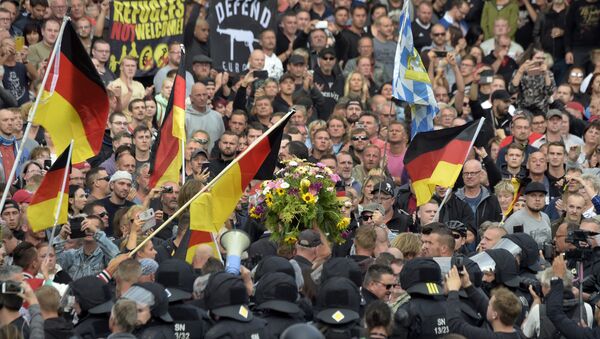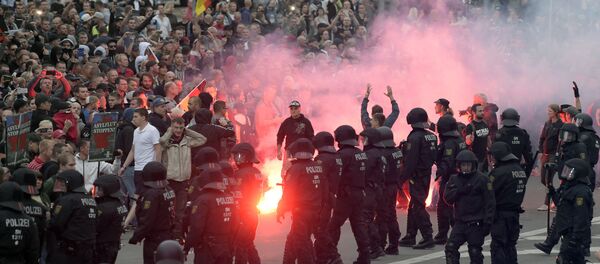The Spark That Lit the Fire
A Syrian and an Iraqi in their early 20s allegedly stabbed to death Daniel Hillig, a 35-year-old German carpenter, in the city of Chemnitz in Saxony in the morning of August 26. Two more people were wounded; one of them was identified by the Russian embassy as Dmitry M. His condition was described as "satisfactory."
Police reported that the fatal incident had taken place following a verbal confrontation on the sidelines of a public festival. It is yet unclear what triggered the fight; the two men have been arrested on suspicion of manslaughter.
Out in the Street
Later on Sunday, some 800 people gathered an impromptu memorial for the victim near the Karl Marx monument in the city center, chanting "We are the people," a slogan largely associated with right-leaning supporters.
Nach dem #Messer-Mord beim Stadtfest in #Chemnitz haben sich heute etwa 1000 Bürger versammelt.
— Aufbruch (@aufbruchDD) 26 августа 2018 г.
Für morgen, 27. August 2018, ist eine Demonstration um 18:30 Uhr am „Nischel“ (Karl-Marx-Monument) angekündigt. pic.twitter.com/5IYjdx2vAQ
The number of demonstrators has climbed quickly; in videos posted online, some of them can be seen chasing people they believe to be foreigners. This provoked the condemnation of German officials, including Chancellor Angela Merkel, who said "vigilante justice" could not be tolerated.
#Chemnitz, #Germany, 26 August 2018: ~1000 neonazis hunt refugees and immigrants, attacking who does not look sufficiently german.
— rui borges (@homo_viator) 27 августа 2018 г.
The far-right riding hate is now near of being the 2nd party.
Night falls on this #Europe of crystal. pic.twitter.com/RYn7Ucy9vK
The rallies, which took the authorities by surprise, descended into chaos as riot police tried to contain the crowd later in the day.
Videos zeigen Ausschreitungen von #Chemnitz: Der rechte Mob in den Straßen https://t.co/IkvoUqn3pw pic.twitter.com/0okIdNNufS
— SPIEGEL ONLINE (@SPIEGELONLINE) 27 августа 2018 г.
Left-Wing Protests Flare Up
On Monday, the number of anti-immigrant protesters near the Karl Marx monument grew to 6,000 people, many of whom had travelled to Chemnitz from other states. Neo-Nazis and hooligans also turned up at the heart of the city, chanting "Foreigners out" and performing Hitler salutes, which are outlawed in Germany.
VIDEO: Thousands of German right wing extremists surround Karl Marx statue & chant Nazi slogans at anti-racist demonstrators as one makes the Hitler salute amid clashes #Chemnitz #c2708 #Antifa @Ole_Bonsey @DeadIrishRebel @enough14 @IAF__FAI @TheBaseBK pic.twitter.com/YMdZBeZHfI
— The Tocsin (@TheTocsin) 27 августа 2018 г.
Neonazis marschieren durch #Chemnitz #c2708 pic.twitter.com/vlwNwcx7I8
— KulturbüroSachsen (@KBSachsen) 27 августа 2018 г.
Right-leaning demonstrators carried flowers and German flags and were cheered on by a crowd.
Far right? Or ordinary Germans sick and tired of being attacked by Merkels migrants? #Chemnitz pic.twitter.com/PHU0kV9Kvv
— Katie Hopkins (@KTHopkins) 27 августа 2018 г.
An angry crowd was filmed calling for the deportation of immigrants.
« Abschieben! Abschieben! » (Expulsions! Expulsions!), scandent ces manifestants — ils sont plusieurs milliers — qui protestent contre « l’immigration de masse » ce soir à Chemnitz, au sud de la Saxe, rassemblés au pied de l’immense buste de Karl-Marx pic.twitter.com/tA5Z1l4Q1i
— Thomas Wieder (@ThomasWieder) 27 августа 2018 г.
Scuffles broke out in the city after nearly 1,500 left-wing activists struck back at the anti-immigrant protesters. Police used pepper spray and water cannons against two large groups of demonstrators, who were throwing projectiles at each other, leaving 18 protesters from both sides as well as two police officers wounded.
The death of a 35-year-old German man during an altercation involving
— Dana Regev (@Dana_Regev) 28 августа 2018 г.
migrants on Sunday had sparked two days of violent protests in #Chemnitz.
At least six people were injured Monday as rival far-right and left-wing protesters clashed, @dpa reports. https://t.co/2tgRsq1bBI pic.twitter.com/A6MbGmDHBc
Keeping Strife Away
On Tuesday, reports surfaced that police were probing ten protesters accusing of giving the banned Hitler salutes. The Chemnitz protests moved away from the city, with anti-Nazi activists hitting the streets of Dresden, Cologne, and Leipzig. In the videos circulated on social media, people can be seen calling to stop the violence and chanting "Nazis out!"
Cologne's antifa and far-right stage show of force following anti-migrant protests in #Chemnitz pic.twitter.com/V4fadfP87f
— Ruptly (@Ruptly) 29 августа 2018 г.
Demonstrationen nach den Vorfällen in #Chemnitz am Abend in #Köln.#Koeln2808 #c2608 @ZDFheute pic.twitter.com/BufsoI0yfT
— ZDF-Landesstudio Nordrhein-Westfalen (@ZDFnrw) 28 августа 2018 г.At the same time, some local residents insisted that Chemnitz wasn't a "city of fascists" and that that immigrants shouldn't be afraid.
#Chemnitz residents react to violent anti-immigration protests#Voxpop #Germany pic.twitter.com/xmJANiDMIS
— Ruptly (@Ruptly) 28 августа 2018 г.
Others argued that it's better to stay home, citing safety concerns.
My parents say 'don't go in the city, stay at home'.#Chemnitz #Voxpop #Germany pic.twitter.com/TarV0FPOFd
— Ruptly (@Ruptly) 28 августа 2018 г.
Chancellor Merkel condemned "hate on the streets" on Tuesday and insisted that local security forces were doing their best to prevent violence.
#Chemnitz protests have become a 'witch hunt' — #Merkel after violent rally on Monday pic.twitter.com/KNCsiirSFh
— Ruptly (@Ruptly) 28 августа 2018 г.
However, she welcomed an offer by Interior Minister Horst Seehofer, who said the federal government could provide assistance to the local authorities amid muted calls by some right-wing groups for a third evening of demonstrations.
The Chemnitz unrest brought to light the thorny issue of migration in Germany. In 2015, the country took in over one million refugees amid the European migration crisis as part of what Chancellor Angela Merkel called an "open-door policy." Ever since, multiple reports have attributed responsibility for gruesome murders and rape cases to immigrants and asylum-seekers living in Germany, provoking a vigorous public outcry over Merkel's immigration policy and igniting a row that has threatened to break up her coalition government.
This year, Berlin has sought to avoid a repeat of the migration crisis. In order to tackle illegal immigration, the German interior ministry established "transfer centers" and "anchor centers" to hold and process migrants who had entered the country illegally.





